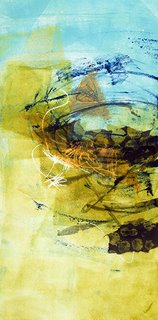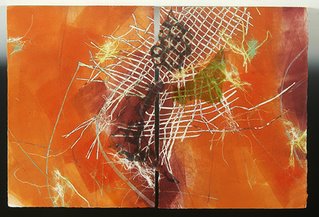

The two works above are monotypes by Melissa P. Hackmann entitled "Awake" and "Landing." I met Melissa through gallery "auntie" and Blogging for your Business PR maven Denise Graveline about three months ago. Melissa also has a blog from which I learned that she had done an open studio event that I missed. I asked her if I could still visit her studio and she graciously hostessed me, feeding me snacks and showing me her fantastic work, which ranges from flat collage, to 3D assemblage, to painting, to book making, to print making, to drawing. What struck me most about Melissa as an artist and Melissa as a person is that she LOVES texture. Her work in monotype is all about how the textures of different objects translate when pressed into paper.
To clarify, the monotype process is a printing process that creates, rather than a series of prints, one print. Classic monotype is achieved by drawing a design on the plate with printing ink and then running the plate through the printing press while the ink is still wet to transfer the image onto a sheet of paper. A monotype only has one impression (occasionally there will be a second, much lighter impression), which makes the process interesting as a typically serial process, printing, is used to produce an original work of art that cannot be reprinted.
In the above works and the one below, Melissa has used ink, what looks like cheesecloth, and a process called chine colle to produce the final image on the paper (more on chine colle later). The cheesecloth adds both texture and white space to the image. The original plate may have been entirely inked, but with the addition of the fabric, the ink was only transferred to the paper around and through the holes in the fabric, which is evident in the white space added by the loosely woven fabric in "Warmed By You," below.
 Art Lesson #2: roughly translated "chine" means tissue paper, since the tissue paper originally used in the process was imported from Asia, and "colle" (with an accent on the E that I can't achieve in Blogger) means paste. The process involves printing the image from the plate onto the tissue paper, which then, either from the addition of paste or from the sheer pressure of the printing press, gets stuck to a heavier sheet of paper placed behind it. Originally chine colle was used to print an image on a whole sheet of tissue paper because the tissue made it easier to see the fine details in the printed image. But the tissue wasn't strong enough on its own and needed to be attached to a heavier sheet of paper, hence the "colle" part. Most of the chine colle I see now is done more for the added interest of collaged bits of tissue paper on a print than for the image-holding properties of the tissue itself.
Art Lesson #2: roughly translated "chine" means tissue paper, since the tissue paper originally used in the process was imported from Asia, and "colle" (with an accent on the E that I can't achieve in Blogger) means paste. The process involves printing the image from the plate onto the tissue paper, which then, either from the addition of paste or from the sheer pressure of the printing press, gets stuck to a heavier sheet of paper placed behind it. Originally chine colle was used to print an image on a whole sheet of tissue paper because the tissue made it easier to see the fine details in the printed image. But the tissue wasn't strong enough on its own and needed to be attached to a heavier sheet of paper, hence the "colle" part. Most of the chine colle I see now is done more for the added interest of collaged bits of tissue paper on a print than for the image-holding properties of the tissue itself.
In her work Melissa uses both plain colored tissue paper to add color and printed tissue to add texture and visual interest. In all three of the pieces above she uses a black and white dotted tissue that adds a lot of visual punch. In "Warmed By You," she has taken the possibilities of chine colle a step farther by attaching two separate sheets of paper together with the tissue paper and printing on both sheets to create a diptych monotype.
Melissa has impeccable color and design sense. I get a sense of almost unbridled enthusiasm from her work, but I also feel that she really knows when to stop. There are moments of swirling chaos as well as calm serenity in each of her pieces. But what really makes her work stand out for me is her use of texture to bring the work together, literally in the case of "Warmed By You," and transform each piece from a pretty picture into something really interesting to look at.
To clarify, the monotype process is a printing process that creates, rather than a series of prints, one print. Classic monotype is achieved by drawing a design on the plate with printing ink and then running the plate through the printing press while the ink is still wet to transfer the image onto a sheet of paper. A monotype only has one impression (occasionally there will be a second, much lighter impression), which makes the process interesting as a typically serial process, printing, is used to produce an original work of art that cannot be reprinted.
In the above works and the one below, Melissa has used ink, what looks like cheesecloth, and a process called chine colle to produce the final image on the paper (more on chine colle later). The cheesecloth adds both texture and white space to the image. The original plate may have been entirely inked, but with the addition of the fabric, the ink was only transferred to the paper around and through the holes in the fabric, which is evident in the white space added by the loosely woven fabric in "Warmed By You," below.
 Art Lesson #2: roughly translated "chine" means tissue paper, since the tissue paper originally used in the process was imported from Asia, and "colle" (with an accent on the E that I can't achieve in Blogger) means paste. The process involves printing the image from the plate onto the tissue paper, which then, either from the addition of paste or from the sheer pressure of the printing press, gets stuck to a heavier sheet of paper placed behind it. Originally chine colle was used to print an image on a whole sheet of tissue paper because the tissue made it easier to see the fine details in the printed image. But the tissue wasn't strong enough on its own and needed to be attached to a heavier sheet of paper, hence the "colle" part. Most of the chine colle I see now is done more for the added interest of collaged bits of tissue paper on a print than for the image-holding properties of the tissue itself.
Art Lesson #2: roughly translated "chine" means tissue paper, since the tissue paper originally used in the process was imported from Asia, and "colle" (with an accent on the E that I can't achieve in Blogger) means paste. The process involves printing the image from the plate onto the tissue paper, which then, either from the addition of paste or from the sheer pressure of the printing press, gets stuck to a heavier sheet of paper placed behind it. Originally chine colle was used to print an image on a whole sheet of tissue paper because the tissue made it easier to see the fine details in the printed image. But the tissue wasn't strong enough on its own and needed to be attached to a heavier sheet of paper, hence the "colle" part. Most of the chine colle I see now is done more for the added interest of collaged bits of tissue paper on a print than for the image-holding properties of the tissue itself.In her work Melissa uses both plain colored tissue paper to add color and printed tissue to add texture and visual interest. In all three of the pieces above she uses a black and white dotted tissue that adds a lot of visual punch. In "Warmed By You," she has taken the possibilities of chine colle a step farther by attaching two separate sheets of paper together with the tissue paper and printing on both sheets to create a diptych monotype.
Melissa has impeccable color and design sense. I get a sense of almost unbridled enthusiasm from her work, but I also feel that she really knows when to stop. There are moments of swirling chaos as well as calm serenity in each of her pieces. But what really makes her work stand out for me is her use of texture to bring the work together, literally in the case of "Warmed By You," and transform each piece from a pretty picture into something really interesting to look at.
No comments:
Post a Comment